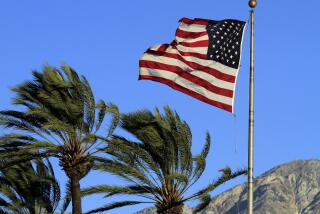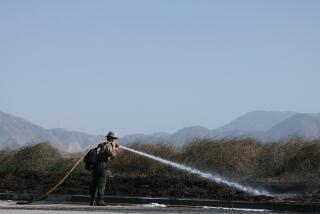Wind and low humidity bring elevated fire risk to parts of Southern California

Late summer in California always brings fire risks, but that’s particularly so during the second year of drought as the effects of climate change intensify around the globe.
And so, elevated fire weather conditions are expected through Sunday across Southern California’s interior valleys, mountains and deserts, along with brief periods of critical fire weather conditions in those areas throughout the weekend.
“We have strong onshore winds and it’s still warm out there. And it’s also still really dry,” said Kristen Stewart, a meteorologist with the National Weather Service in Oxnard.
Stewart said the brief periods of critical fire weather will probably be in the San Gabriel Mountains and the Antelope and Santa Clarita valleys in the afternoon and early evenings, when winds are likely to be strongest.
There is some good news, though: Even though several areas are expected to see windows of critical fire danger, the conditions will not be widespread enough to warrant a red flag warning from the National Weather Service.
And after multiple record-setting heat waves this summer, the heat forecast for this weekend looks comparatively balmy, with temperatures in the upper 80s and low 90s in the inland valleys and the upper 70s to the low 80s in Los Angeles proper. The mercury will probably hover around 100 degrees in the Antelope Valley.
But, as Stewart explained, heat is “not necessarily a super big factor” for fire risk unless temperatures are well into the triple digits. The danger this weekend will stem from the gusty winds, particularly in the inland deserts, and the low humidity, with the driest conditions expected in the Antelope Valley. Humidity in the affected areas is expected to hover from the teens into the single digits.
“If we get in the single digits, it’s bone dry,” Stewart said.
She stressed that with no rain expected any time soon, Southern Californians should remain fire-aware.
“We’re still going to be seeing elevated fire conditions at least through the summer, and then we’ll have Santa Ana [wind] season coming up in a couple months. So we can’t let our guard down until we at least get some rain later on in the winter,” she said.
Drought, climate change and an early start to fire season mean this fall could be one of fire, smoke, poor air quality and evacuations in Southern California. Here’s how you can prepare now.
Several fires continue to burn around the state, with the destructive Dixie fire now the third-largest wildfire in recorded California history and the largest to burn in the U.S. this year, surpassing the massive Bootleg fire in Oregon. As of Thursday, the state had seen an astounding 151% increase in acres burned across California compared with this time last year, according to the California Department of Forestry and Fire Protection.
Smoke from those fires is affecting air quality in parts of Northern California and the Central Valley. Local health officials issued a smoke-related health caution Friday for the entire San Joaquin Valley. On Friday evening, air quality conditions in parts of the Sierra Nevada and northern Central Valley were considered hazardous, according to the federal AirNow index.
Hazardous air quality conditions were also logged Friday in Northern California’s Trinity and Shasta counties, with planned COVID-19 vaccination clinics in Trinity County canceled Friday and Saturday because of the poor air quality.
In the Bay Area, officials issued an air quality advisory through Saturday, writing, “Smoky, hazy skies will be visible across the Bay Area and smoke may impact localized regions such as in Napa, Sonoma and Solano counties, and higher elevation location.”
Experts agree that the effects of climate change are an inextricable factor in California’s worsening fire seasons.
“The exceptional fire weather this year and in recent years does not represent random bad luck,” Jacob Bendix, a Syracuse University professor who specializes in pyrogeography, or the study of wildfire distribution, told The Times last month. “It is among the results of our adding carbon to the atmosphere — results that were predictable, and indeed that have been predicted for decades.”
Times staff writer Hayley Smith contributed to this report.
More to Read
Start your day right
Sign up for Essential California for news, features and recommendations from the L.A. Times and beyond in your inbox six days a week.
You may occasionally receive promotional content from the Los Angeles Times.








